
Living in Mexico is, on average, about 40% cheaper than the United States, with rent nearly 60% lower.
A single person can live on roughly $700 a month (excluding rent), while a family of four may spend $2,500+. But costs swing widely by city, lifestyle, and whether you hold Mexican citizenship.
Your monthly budget could cover a modest apartment inland for under $400 or stretch into $1,000+ for a beachside condo. Groceries and healthcare are significantly cheaper than in the U.S., but micro-markets like Playa del Carmen or Cabo bring sticker shock.
The central question becomes: what's comfortable for you?
We help U.S.-born Mexicans and their families secure their Mexican citizenship, which directly impacts your cost of living. Citizens enjoy fewer restrictions on property, access to public healthcare, and lower long-term residency costs. These advantages expats without citizenship simply don't have.
If you want the full breakdown on housing, food, healthcare, utilities, and what it takes to live on $1,000, $2,000, or $3,000 a month in Mexico, keep reading. We'll also show you how your legal status can make the difference between scraping by and living comfortably.
What's the Average Cost of Living in Mexico?
The latest data shows that Mexico is roughly 40% cheaper than the United States.
On average, a single person spends around $699 per month (excluding rent), while a family of four averages about $2,532 (excluding rent). Rent is where you'll see the biggest difference: housing costs are nearly 59% lower than in the U.S.
But these are national averages. Your budget depends heavily on where in Mexico you choose to live:
- Mexico City & beach towns (Puerto Vallarta, Cabo, Cancún): Expect higher rents and dining costs, with one-bedroom apartments in expat-heavy areas often between $700-$1,000+. Buying property in prime beachfront locations can start near $250,000 USD for a condo.
- Interior cities (Puebla, Querétaro, Guadalajara, Mérida): Considerably cheaper, with one-bedrooms ranging from $300-$500, and overall monthly budgets running 20-30% below tourist zones.
- Small towns & rural areas: Rent can drop below $250-$350, utilities are lighter (often under $20-$30 without A/C), and fresh food from local markets is significantly cheaper than big-box chains.
Everyday costs are also noticeably different from the U.S. A meal at a local restaurant averages 100-350 MXN ($6-$20 USD), a cappuccino ranges from 35-100 MXN ($2-$6 USD), and public transportation can cost as little as 7-16 MXN (under $1 USD) per ride.
Meanwhile, specialist doctor visits are typically $25-$50 USD without insurance, and pharmacy clinics can charge a few dollars for minor care.
The takeaway: Living in Mexico can feel very affordable, but your comfort level hinges on city choice, lifestyle, and whether you're renting, buying, or already own property.
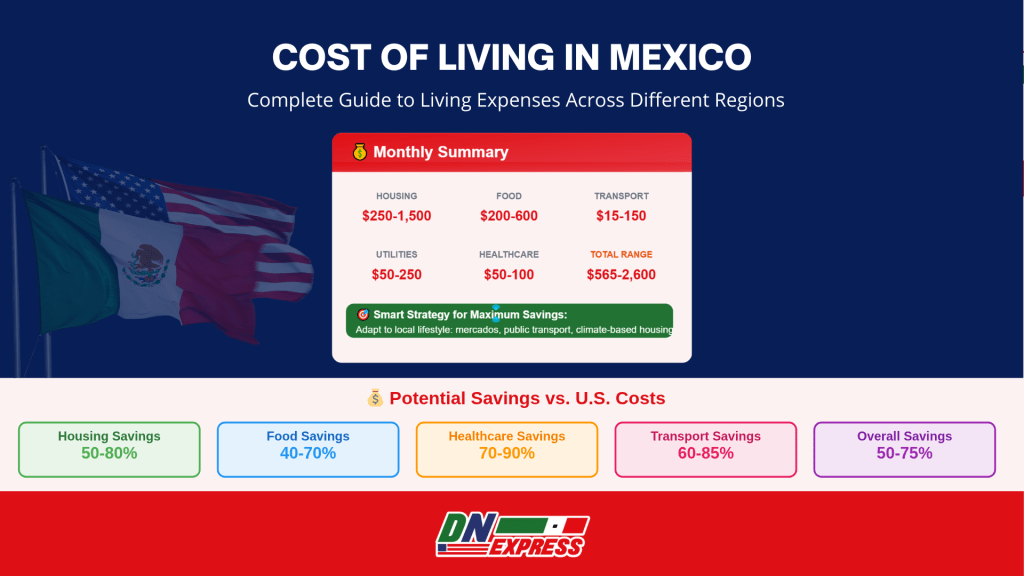
Housing is the single biggest factor shaping your cost of living in Mexico.
Rents vary widely depending on city size, proximity to expat hubs, and how “local” you're willing to live.
- Big-city and tourist hubs: A one-bedroom apartment in Puerto Vallarta, Cabo, or Mexico City typically runs $400-$900 USD per month. Upscale neighborhoods or trendier districts can easily climb into the $1,000-$1,500 range.
- Interior and mid-sized cities: Puebla, Querétaro, and Guadalajara often see rents closer to $300-$500 for a one-bedroom, with three-bedrooms available for $600-$800.
- Rural towns and smaller communities: Housing can drop below $250-$350 USD per month, especially when you're outside the tourist orbit.
Buying property shows the same contrast. Beach condos in Cancún or Puerto Vallarta often start around $250,000 USD for a two-bedroom, while in inland towns the same budget could buy a spacious home with land.
But here's what most guides don't tell you: Mexico's housing market is full of hidden gaps. Touristic “micro-markets” like Playa del Carmen or San Pancho can feel incredibly pricey, rivaling U.S. rents despite being in Mexico.
Meanwhile, many affordable rentals are never listed online. Working with local Spanish-speaking agents, or simply walking neighborhoods and asking, can unlock deals foreigners rarely see.
Finally, actual relocation costs go beyond Mexican expenses. Many of our DNExpress clients maintain dual-country expenses during their transition, such as U.S. storage, mortgage, or insurance. These hidden line items can quietly inflate your budget until your move is fully settled.
The bottom line: housing in Mexico can be cheap, but your outcome depends on location, strategy, and whether you're carrying U.S. costs alongside Mexican ones.
Food and Groceries: Markets vs. Chains
Food in Mexico is where many people notice the biggest savings compared to the U.S.
But where you shop makes all the difference.
- Local markets (mercados, fruterías, carnicerías): Prices are typically 15-20% lower than supermarkets. A dozen eggs often runs $2-3 USD, chicken $2-5 per pound, and seasonal produce as low as $0.50-$1 per pound. Buying fresh and local doesn't only save money, it keeps you plugged into community life.
- Supermarkets and big-box chains (Soriana, Walmart, Costco): Convenient but pricier. Imported goods like certain cereals, wine, or U.S. snack brands can cost as much as back home. Families juggling U.S. and Mexican life often compare Costco Mexico to Costco U.S. to decide which staples to haul across borders.
- Street food and small restaurants: A full meal can cost $3-$7 USD, far cheaper than cooking in some cases. Tacos, tortas, and daily lunch specials (comida corrida) keep costs low and variety high.
For families, cooking at home remains the most economical option.
Many of our clients tell us that adjusting to Mexican shopping habits, weekly markets instead of one big-box trip, cuts their grocery bills without sacrificing quality.
👉 Tip: If you're planning a move, budget generously at first. Imported “comfort foods” may tempt you in supermarkets, but once you adapt to local staples, food costs become one of the easiest ways to keep your living expenses lean.
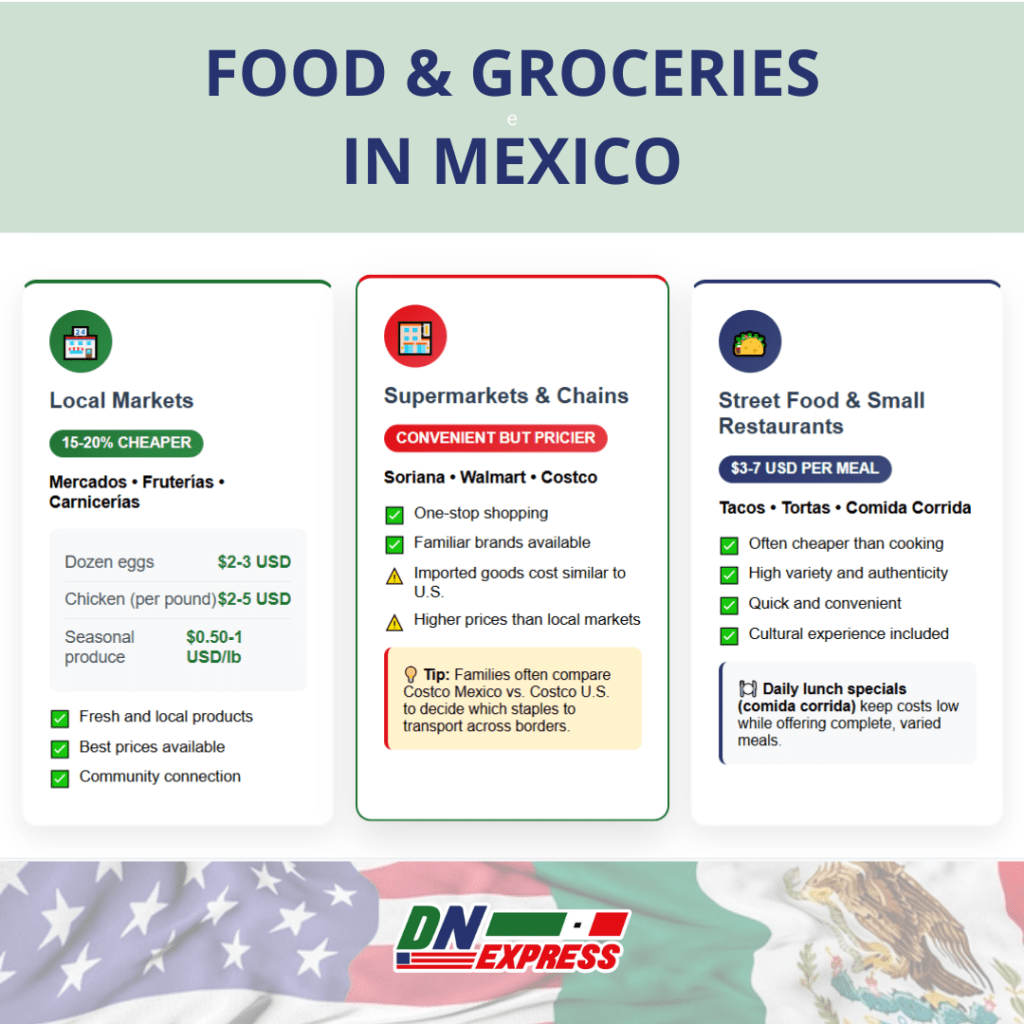
Transportation: Cars, Buses, and Hidden Costs
Getting around in Mexico can be remarkably affordable if you don't own a car.
- Public transit: City buses and metro systems cost as little as $0.50-$1 USD per ride. In cities like Mexico City or Guadalajara, a monthly pass might run $15-$40 USD, making it one of the cheapest transportation systems in the region.
- Ride-hailing apps: Uber, DiDi, and inDrive rides typically fall in the $3-$4 USD range for short city trips. For many expats and locals, this replaces the need for car ownership entirely.
- Taxis: In smaller towns or places with limited app coverage, taxis average around $4 per ride, which still beats the cumulative costs of fuel and maintenance.
Owning a car, however, quickly changes the math.
Gasoline often hovers around $5 per gallon, and drivers must also factor in insurance, permits, registration, parking, and repairs. Those added costs can rival U.S. expenses.
Your location and lifestyle also play a role. Interior cities, with mild climates and walkable centers, make it easy to get by without a car.
By contrast, coastal zones where heat and distance dominate often make car ownership feel less like a luxury and necessary.
The takeaway: If you're comfortable relying on buses, rideshares, or taxis, transportation in Mexico is a budget-friendly category. If you need a personal vehicle, expect to allocate a U.S.-style chunk of your budget to cover it.
Utilities & Internet: Climate Is the Decider
Utility bills in Mexico are one of the most unpredictable parts of a household budget because they depend heavily on climate and location.
- Central highlands (mild climate): In places like Guadalajara, Querétaro, or San Miguel de Allende, many homes don't even use heating or air conditioning. Here, electricity bills can be astonishingly low, sometimes as little as $10-$20 USD per month.
- Coastal zones (hot & humid): Living near the beach often means round-the-clock air conditioning. In Cancún, Puerto Vallarta, or Mérida, monthly electricity bills can jump to $80-$200 USD or higher, especially in summer.
Other basics remain affordable: water usually costs under $10 USD per month, and bottled gas for cooking and heating might add another $20-$30 USD.
On the digital side, Mexico has caught up quickly. Fiber internet with speeds of 100 Mbps is available in many towns for about $18 USD per month, a bargain for remote workers.
One underappreciated benefit of holding Mexican citizenship is access to subsidized utility programs.
Nationals can sometimes qualify for lower electricity rates through government programs, an advantage that foreigners without citizenship may not enjoy.
👉 Bottom line: Your utility costs could range from negligible to significant, depending on whether you choose a breezy inland city or a coastal paradise. The climate, and your citizenship status, will determine how much you spend each month.
Healthcare: From IMSS to Private Clinics
Healthcare in Mexico is one of the country's strongest advantages for residents and retirees.
Costs are far lower than in the U.S., and you'll find a mix of public and private systems to choose from.
- Private care: Specialist visits typically cost $25-$50 USD without insurance. Many private hospitals in Mexico's larger cities rival U.S. facilities in quality at a fraction of the price. Insurance is optional, though plans are available for those who want extra security.
- Pharmacy clinics: For minor illnesses, walk-in clinics attached to pharmacies charge a few dollars, making everyday healthcare extremely affordable.
- IMSS (Instituto Mexicano del Seguro Social): Legal residents can enroll in this public system for an annual fee that scales with age. It covers most major services, but wait times can be long and availability varies by location. For budget-conscious expats, IMSS is a viable option, though many supplement it with private care.
Does Mexico have free healthcare?
Not exactly. Emergency care is provided regardless of ability to pay, and some public programs (like INSABI) cover residents. However, most foreigners and expats must pay into IMSS or use private care.
How much does healthcare cost monthly?
Without insurance, everyday needs might only add $50-$100 USD per month for doctor visits and medications. With private insurance, costs vary widely but remain lower than U.S. premiums.
Why Citizenship Matters
Dual citizens have access to the same healthcare systems as Mexican nationals without foreigner surcharges or legal hurdles.
We've seen families save thousands over time simply by unlocking their right to Mexican nationality, which opens doors to public programs and reduces the reliance on private-only care.
👉 Healthcare is not only cheaper in Mexico, it's also flexible. Your comfort will depend on whether you lean on public options, private providers, or a mix of both.

Life Budgets: Singles, Couples, Families
While national averages provide a starting point, actual living costs depend on where you settle and the lifestyle you choose.
Here are practical examples:
- Single in Oaxaca: Living on less than $1,500 USD per month is realistic, with rent around $300-$400 and modest utilities. Groceries and street food keep costs low, and no car is needed.
- Couple in Cabo (no mortgage): A budget of $2,000 USD+ is common. Even without rent, entertainment, dining out, and A/C bills raise the monthly total. Renting instead of owning adds another $700-$1,000 USD.
- Single in San Miguel de Allende exurbs: Those relying on IMSS and avoiding car ownership report getting by on $1,200 USD per month or less, but living farther from the city center requires compromises.
- Couple in Playa del Carmen: Costs can easily double compared to inland towns, with rents resembling U.S. levels. A comfortable lifestyle for two often requires $2,500-$3,000 USD per month.
Some numbers
- Is $1,000 USD enough? Yes, but it's tight. Inland cities with low rents make it possible, though savings are slim.
- Is $2,000 USD/month comfortable? In most cities, yes. This budget covers rent, food, transport, and modest extras for a couple or family.
- Can I retire with $3,000 USD/month? Absolutely. Even in pricier coastal regions, this level allows for private healthcare, dining out, and travel.
👉 The key lesson: Your monthly number means less than your location and lifestyle choices. Inland towns reward modest budgets; coastal resorts demand extra cushion.
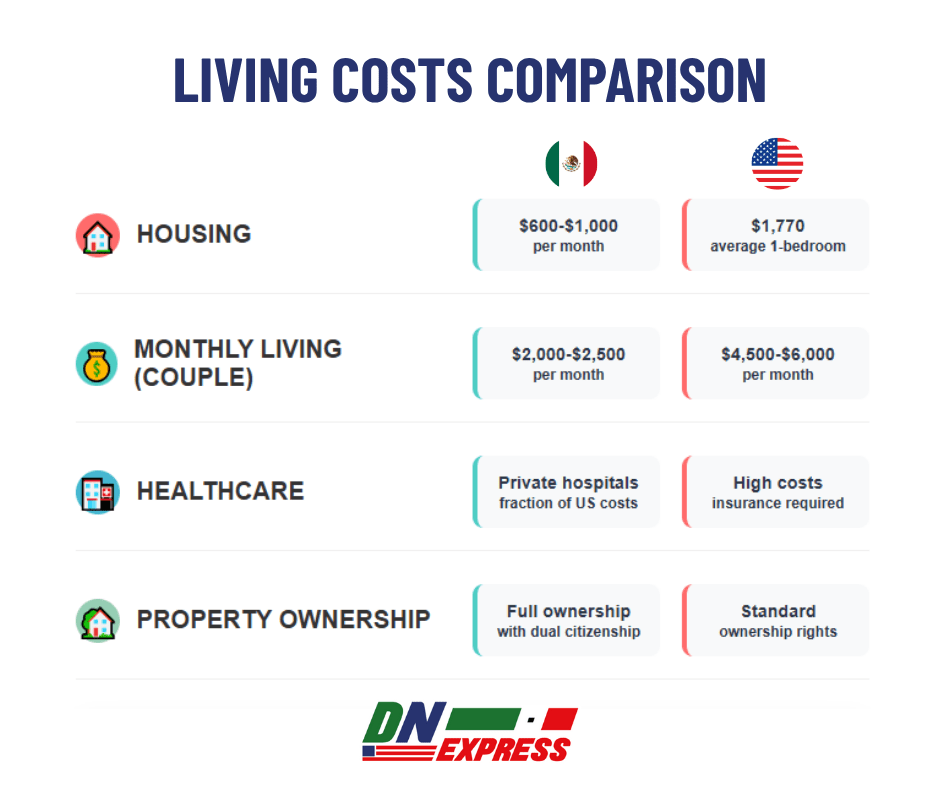
Cheapest and Safest Cities to Live
When people ask about the best cities to live in Mexico, they're usually looking for a mix of affordability and safety, not the lowest rent.
- Querétaro: A growing city with a strong middle class, modern infrastructure, and relatively low crime. A family of four can live well on $2,600 USD/month, and one-bedroom apartments often rent for $400-$500 USD.
- Mérida: Frequently ranked as one of Mexico's safest cities. Housing is affordable, $350-$600 USD for apartments, and utilities are modest outside the hottest months. Popular with retirees for its healthcare and walkability.
- Guadalajara: Mexico's second-largest city offers cosmopolitan living at lower costs than Mexico City. Safe neighborhoods with rents in the $500-$700 USD range balance affordability with big-city conveniences.
The Safety Factor
Affordability alone doesn't tell the full story.
Some cheap towns may not meet safety expectations, especially for families or retirees. That's why many expats gravitate toward cities with both low costs and strong reputations for security.
Why Citizenship Matters
For dual citizens, the map of “affordable and safe” expands.
Mexican nationals can buy and rent property in areas legally restricted to foreigners, such as beachfront zones and certain border regions. This flexibility gives you choices, often at prices out of reach for non-citizens.
Bottom line: Querétaro, Mérida, and Guadalajara consistently strike the best balance between affordability, safety, and quality of life. Holding Mexican citizenship unlocks even additional options.
Beyond Costs: The Hidden Price of Doing It Alone
When calculating the cost of living in Mexico, it's easy to focus on housing, food, and utilities.
But for many families, the hidden expense comes from the legal side, specifically, securing Mexican citizenship or residency.
Too often, people try to handle the process themselves, only to hit costly setbacks:
- DIY applications rejected due to name mismatches, untranslated documents, or missing apostilles.
- Wasted trips to consulates, sometimes after waiting six months for an appointment, only to be told “no.”
- Months or years lost, with families forced to juggle U.S. housing, storage, or travel costs while their paperwork stalls.
We've built our reputation by solving exactly these problems. Every case is reviewed by licensed Mexican attorneys, not outsourced processors.
We locate missing records, fix clerical errors, and file applications through no-consulate-required channels, saving our clients both time and money.
One client summed it up best: “The consulate told me I wasn't eligible. DNExpress reviewed my case, found the mistake, and got it done in weeks. I had my Mexican birth certificate in hand before I even expected it.”
👉 The lesson: Going the DIY route can seem cheaper, but the hidden costs, delays, travel, and rejection, often make it the most expensive choice of all.
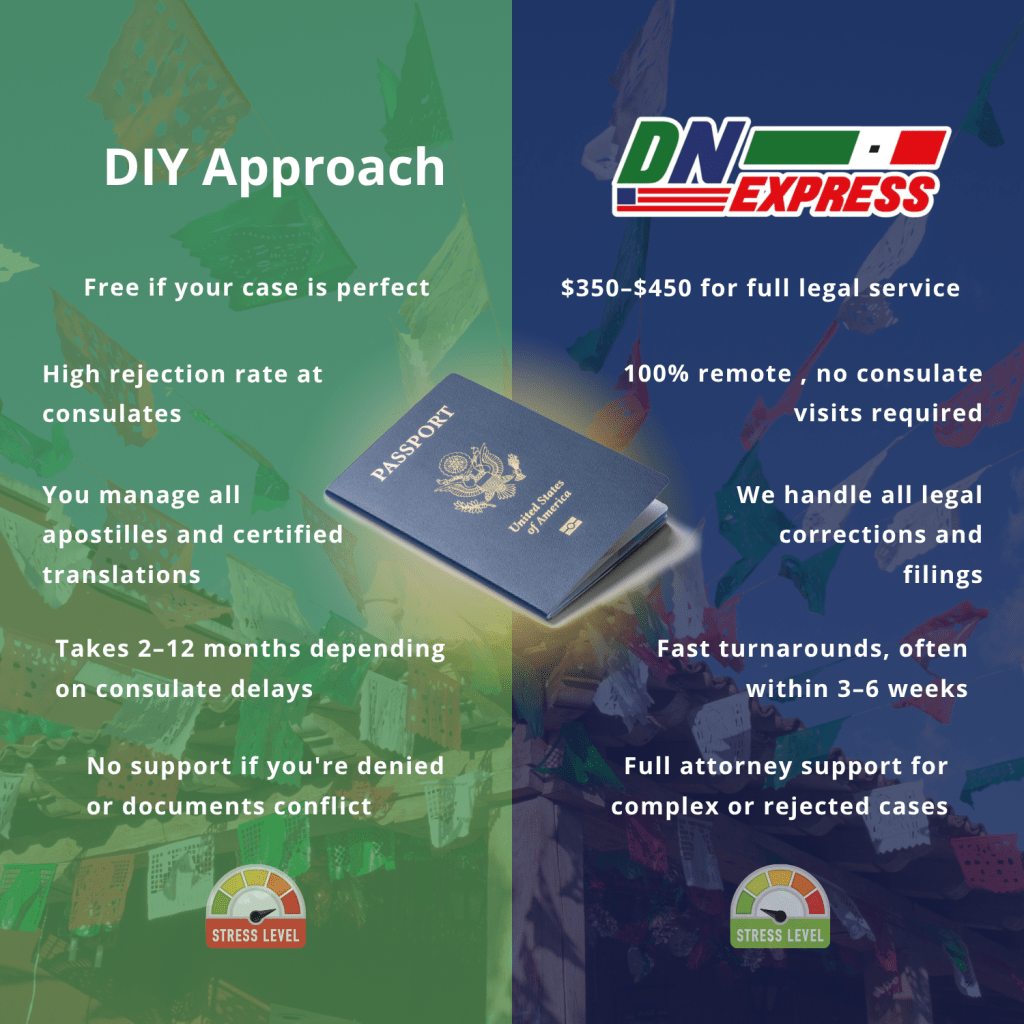
Why Work With Doble Nacionalidad Express?
If you're considering life in Mexico, securing your Mexican citizenship is one of the smartest financial and legal moves you can make.
But choosing the right partner for that process matters as much as the outcome.
Here's why families across the U.S. trust Doble Nacionalidad Express:
- Handled by Licensed Attorneys – Every case is reviewed and supported by Mexican attorneys, not document processors. You get answers grounded in law, not guesswork.
- No Consulate Visits Required – We complete the entire process remotely, sparing you the stress of scheduling or traveling for consulate appointments.
- Affordable, Transparent Pricing – Our fees are designed for working families, with clear payment plans and no hidden surprises.
- Specialists in Rejected or Difficult Cases – Where others give up, we step in. We've helped thousands who were told “no” finally reclaim their nationality.
- U.S. and Mexico Coverage – With offices and a network of local agents across both countries, we can track records, resolve errors, and finish cases efficiently.
- Proven Results, Client Stories – Parents registering their U.S.-born kids. Retirees finally unlocking Mexican healthcare. Young professionals buying property without foreigner restrictions. Our clients consistently tell us, “DNExpress made what felt impossible simple.”
For us, this goes beyond paperwork. It's restoring identity, protecting families, and making sure you enjoy every advantage Mexico has to offer.
Take the Next Step
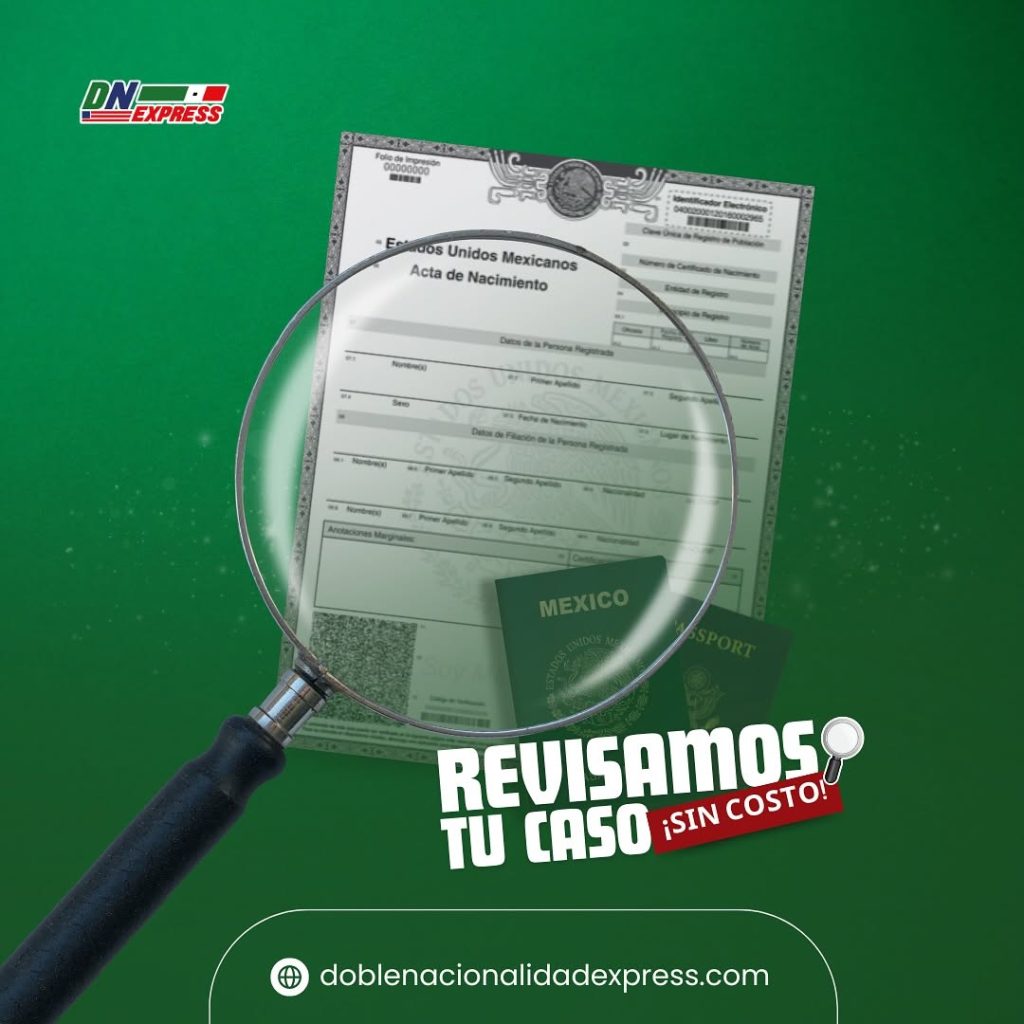
The fact that the consulate told you “no” doesn't mean it's over.
We've helped thousands of families turn rejections into approvals, and we can do the same for you.
We offer a free case review, where our legal team examines your situation, identifies roadblocks, and lays out a clear path forward. From start to finish, we handle the process so you can focus on planning your new life in Mexico.
You can reach us however it's easiest for you: call us directly, send a WhatsApp message, or book an online consultation.
Because in the end, Mexican citizenship goes beyond documents. It's about reclaiming your roots, protecting your family's future, and living affordably and fully in Mexico.
We also offer document translation services and help with passport renewals to support your transition.
Frequently Asked Questions (FAQ)
How much money do you need to live comfortably in Mexico?
Most singles live well on $1,200-$1,500 USD per month, while couples often budget $2,000-$2,500 USD depending on city and lifestyle.
Is $1,000 USD a good salary in Mexico?
It's possible in inland towns with lower rent, but it can feel tight. For comfort and savings, most expats aim for $1,500+ USD monthly income.
Is $2,000 a month enough to live in Mexico?
Yes. In most cities, $2,000 covers rent, food, transportation, and extras for a couple. Even coastal areas become manageable at this budget.
Can I retire in Mexico with $3,000 a month?
Absolutely. With $3,000 USD monthly, retirees enjoy private healthcare, dining out, and travel, even in pricier beach destinations.
Where is the cheapest and safest place to live in Mexico?
Querétaro, Mérida, and Guadalajara are top choices, offering a balance of affordability, modern services, and strong safety records.
How much does healthcare cost in Mexico?
Doctor visits are $25-$50 USD, pharmacy clinics cost a few dollars. Monthly costs often fall between $50-$100 USD without insurance.
Does Mexico have free healthcare?
Emergency care is free, and residents can access IMSS or INSABI. Dual citizens enjoy the same access as Mexican nationals.
How much does rent cost in Mexico?
One-bedroom apartments range from $300-$500 USD inland to $700-$1,000+ USD in beach towns or upscale neighborhoods.
What is the cost of utilities in Mexico?
Inland cities average $10-$20 USD per month without A/C. Coastal zones with heavy air conditioning can reach $100-$200 USD monthly.
How much money do you need to get residency or citizenship in Mexico?
Residency requires proving financial solvency, often around $2,000-$2,500 USD in monthly income. Citizenship is based on family heritage, not income, and that's where Doble Nacionalidad Express helps.



